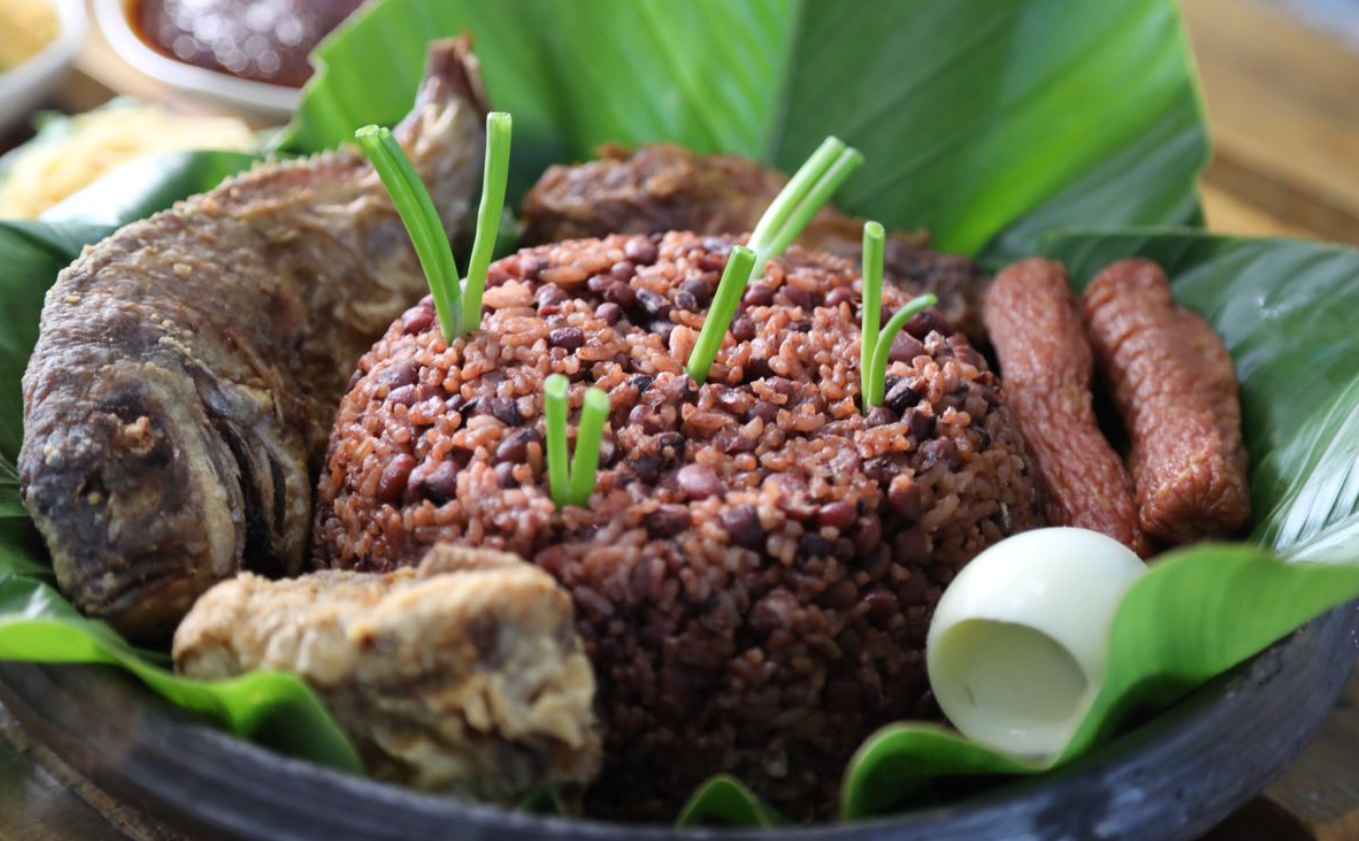Food
How to Prepare Waakye the easiest way

Waakye, a dish made from beans and rice, is a familiar sight to most Ghanaians. This simple, nutritious meal can be found on sale all over the country, from restaurants to street food stall.
INGREDIENTS
- 2 cups rice
- 1 cup black eye beans
- 6-8 waakye leaves
- Salt to taste
INSTRUCTIONS
- Pick stones and grits from the beans.
- Wash the beans and add into the pressure cooker.
- Wash the waakye leaves and also add into the pressure cookers. Pour in water up to the minimum level on the pot.
- Close the valve of the pressure cooker and leave until it reaches full pressure. This should take no more than 15 mins.
- One it reaches full pressure, reduce the heat and leave for additional 10 mins for the beans to cook.
- Remove from heat and allow to cool down naturally to depressurize. This should take around 20 mins.
- Once the pot is adequately cooled. Unlock the lid. Pour the beans with the cooking liquid and the waakye leaves into another pot. Wash the rice and pour into the pot too.
- Add more water if needed so there is enough to cook the rice. Add some salt and cover the pot.
- Allow the rice to cook. The time for this depends on the type of rice used. Check pack instructions if you are not sure.
- Remove the waakye leaves and serve with your favourite side.
History of Waakye
Waakye originated from northern Ghana, where rice and beans are staple food crops. However, it’s not clear which specific ethnic group is responsible for pioneering this national treasure. Depending on where it’s prepared, certain variations exist in its ingredients, like the ratio of rice to beans or the spiciness of the accompanying shitor (hot pepper sauce). Nevertheless, it manages to maintain a generally consistent taste.
Waakye is a combination of red or black-eyed beans and rice, and it’s often served with salads, spaghetti, fried plantains, garri, meat and fish. It’s a delicacy all over the country, and Ghanaians frequently queue at stalls to buy it for their breakfast or lunch.
But waakye has its own unique characteristics, thanks to the many different accompaniments it’s served with. These reflect the influences of all the Ghanaian cultures that have adopted this traditional meal and made it their own. The leaves add flavour and give waakye (pronounced waa-che) its distinctive reddish-brown colour. The leaves are also rich in antioxidants, which in turn can be good for human health.
Waakye is also an excellent choice for vegetarians who want to try out traditional Ghanaian food, as it can be eaten with just salads, juicy fried plantains and spaghetti. When bought from street stalls or restaurants, it’s packaged in broad green leaves, aptly named ‘waakye leaves’. It’s said these leaves are used to prevent the dangers of packaging food in polythene bags,
Waakye is affordable and easy to come by. Indeed, it’s the popularity of the street stalls that has helped to increase the consumption office this dish in major cities like Accra, Kumasi and Cape. So, if you’re in any of these places, do try the local waakye. Pls remember that the best waakye mostly comes from the north. But the health benefits of eating waakye are poorly understood. Antioxidants can protect cells in the body from damage and are thought to help fight a range of illnesses like heart disease, cancer, and diabetes. However, antioxidant levels in food and their effects can be affected by cooking methods, and waakye is no exception.
Food
Cheetos Snacks Ingredients and Honest Review

Cheetos are delicious snacks produced by the PepsiCo group in the United States. Good snacks are not only for satisfaction but are also nutritious for the body. Now the question is, which snack is best for consumption? Let’s examine the ingredients that make Cheetos unique. This explains why Cheetos are considered one of the best snacks to look out for.
About Cheetos
Cheetos were launched in 1948 by Charles Elmer Doolin, and it was branded as Cheetos until 1998, when it was changed to Crunchy Corn Cheese Puff. Frito-Lay is the current producer of Cheetos, and they are mainly distributed in the United States. In 2010, Cheetos was seen as one of the top cheese puffs in the United States. Beyond the United States, Cheetos are also on the shelves of supermarkets in other parts of the world. Again, it is estimated that Cheetos have a worldwide retail sales of $4 billion annually. Would you find it surprising to know that Cheetos is sold in over 36 countries? Well, yes. The original Crunchy Cheetos have been expanded to include other varieties, and these are sold in over 36 countries.
Types of Cheetos
After being in existence for over 77 years, the company has really expanded its branches and the variety of Cheetos they produce. The company currently produces a total of 21 Cheetos varieties. But do all of them have the same nutritional benefits? Let’s have a look at some of the Cheetos varieties, their ingredients, and their nutritional facts.
Cheetos Crunchy
The Crunchy Cheetos was the first or original variety, and it has now been produced in different varieties.
Cheetos Crunchy Cheese Flavored Snacks
Ingredients
- Corn Meal
- Ferrous Sulfate
- Niacin
- Thiamin Mononitrate
- Riboflavin
- Folic Acid
- Corn Oil
- Canola Oil
- Sunflower Oil
- Whey
- Milk
- Cheese Cultures
- Salt
- Enzymes
- Salt
- Corn Maltodextrin
- Natural Protein Concentrate
- Monosodium Glutamate
- Lactic Acid
- Citric Acid
- Artificial Color (Yellow 6)
Nutritional Benefits
The Crunchy Cheese flavor weighs 28g and it has 21 pieces in the sachet. In total you have 160 calories, 1.5g saturated fat, 200mg sodium and 1g sugar.
| Nutrient | Quantity | Percentage |
| Total Fat | 10g | 13% |
| Saturated Fat | 1.5g | 8% |
| Trans Fat | 0g | 0% |
| Cholesterol | 0mg | 0% |
| Sodium | 200mg | 9% |
| Total Carbohydrate | 15g | 6% |
| Dietary Fiber | <1g | 3% |
| Total Sugars | 1g | |
| Protein | 2g | |
| Vitamin D | 0 mcg | 0% |
| Calcium | 10mg | 0% |
| Iron | 0.6mg | 2% |
| Potassium | 60mg |
Cheetos Crunchy Flamin Hot Cheese Flavored Snacks
Ingredients
Enriched Cord Meal
- Corn Meal
- Ferrous Sulfate
- Niacin
- Thiamin Mononitrate
- Riboflavin
- Folic Acid
Vegetable Oil
- Corn Oil
- Canola Oil
- Sunflower Oil
- Salt
- Maltodextrin
- Yeast Extract
- Monosodium Glutamate
- Potassium Salt
- Citric Acid
- Sugar
Artificial Color
- Red 40 Lake
- Yellow 6 Lake
- Yellow 6
- Yellow 5
Cheddar Cheese
- Milk Cheese Cultures
Salt
Enzymes
Onion Powder
Whey
Whey Protein Concentrate
Garlic Powder
Natural Flavors
Buttermilk
Sodium Diacetate
Disodium Inosinate
Disodium Guanylate
Nutritional Benefits
The Crunchy Flamin Cheese flavor weighs 28g and it has 21 pieces in the sachet. In total you have 160 calories, 1.5g saturated fat, 210mg sodium and 0g sugar.
| Nutrient | Quantity | Percentage |
| Total Fat | 11g | 14% |
| Saturated Fat | 1.5g | 8% |
| Trans Fat | 0g | 0% |
| Cholesterol | 0mg | 0% |
| Sodium | 210mg | 9% |
| Total Carbohydrate | 15g | 5% |
| Dietary Fiber | <1g | 3% |
| Total Sugars | 0g | |
| Protein | 1g | |
| Vitamin D | 0 mcg | 0% |
| Calcium | 10mg | 0% |
| Iron | 0.6mg | 2% |
| Potassium | 90mg |
Cheetos Crunchy Flamin Hot Limón Cheese Flavored Snacks
Ingredients
Enriched Corn Meal
- Corn Meal Ferrous Sulfate
- Niacin
- Thiamin Mononitrate
- Riboflavin
- Folic Acid
Vegetable Oil
- Corn Oil
- Canola Oil
- Sunflower
- Salt
- Yeast Extract
- Monosodium Glutamate
- Potassium Salt
- Citric Acid
- Maltodextrin (Made From Corn)
Artificial Color
- Red 40 lake
- Yellow 6 Lake
- Yellow 6
- Yellow 5
Corn Syrup Solids
- Hydrolyzed Corn Protein
Cheddar Cheese
- Milk
- Cheese Cultures
- Salt
- Enzymes
Onion Powder
Sugar
Whey
Lime Juice
Whey Protein Concentrate
Garlic Powder
Natural Flovors
Buttermilk
Sodium Diacetate
Disodium Inosinate
Disodium Guanylate
Nutritional Benefits
The Crunchy Flamin Hot Limon Cheese flavor weighs 28g and it has 21 pieces in the sachet. In total you have 160 calories, 1.5g saturated fat, 200mg sodium and 0g sugar.
| Nutrient | Quantity | Percentage |
| Total Fat | 11g | 14% |
| Saturated Fat | 1.5g | 7% |
| Trans Fat | 0g | 0% |
| Cholesterol | 0mg | 0% |
| Sodium | 200mg | 9% |
| Total Carbohydrate | 15g | 5% |
| Dietary Fiber | <1g | 3% |
| Total Sugars | 0g | |
| Protein | 1g | |
| Vitamin D | 0 mcg | 0% |
| Calcium | 10mg | 0% |
| Iron | 0.6mg | 2% |
| Potassium | 100mg | 2% |
Cheetos Crunchy XXTRA Flamin Hot Cheese Flavored Snacks
Ingredients
Enriched Corn Meal
- Cord Meal
- Ferrous Sulfate
- Niacin
- Thiamin Mononitrate
- Riboflavin
- Folic Acid
Vegetable Oil
- Corn Oil
- Canola Oil
- Sunflower Oil
Salt
Maltodextrin (Made From Corn)
Yeast Extract
Sugar
Monosodium Glutamate
Citric Acid
Artificial Color
- Red 40 Lake
- Yellow 6 Lake
- Yellow 6
- Yellow 5
Hydrolyzed Corn Protein
Cheddar Cheese
- Milk
- Cheese Cultures
- Enzymes
- Potassium Salt
Onion Powder
Whey
Garlic Powder
Natural Flavors
Whey Protein Concentrate
Buttermilk
Sodium Diacetate
Nutritional Benefits
| Nutrient | Quantity | Percentage |
| Total Fat | 10g | 13% |
| Saturated Fat | 1.5g | 7% |
| Trans Fat | 0g | 0% |
| Cholesterol | 0mg | 0% |
| Sodium | 210mg | 9% |
| Total Carbohydrate | 15g | 6% |
| Dietary Fiber | <1g | 3% |
| Total Sugars | 1g | |
| Protein | 2g | |
| Vitamin D | 0 mcg | 0% |
| Calcium | 10mg | 0% |
| Iron | 0.7mg | 2% |
| Potassium | 80mg | 0% |
Cheetos Crunchy Cheddar Jalapeño Cheese Flavored Snacks
Ingredients
Enriched Corn Meal
- Corn Meal
- Ferrous Sulfate
- Niacin
- Thiamin Mononitrate
- Riboflavin
Vegetable Oil
- Corn Oil
- Canola Oil
- Sunflower Oil
Salt
Whey
Maltodextrin
Cheddar Cheese
- Milk
- Cheese Cultures
- Enzymes
- Potassium Salt
Buttermilk
Monosodium Glutamate
Romano Cheese
- Cow’s Milk
Onion Powder
Corn Starch
Natural and Artificial Flavors
Spices
Lactose
Jalapeno Peppers
Garlic Powder
Whey Protein Concentrate
Artificial Color
- Yellow 6
- Yellow 5
- Blue 1
- Red 40
Sodium Caseinate
Skim Milk
Citric Acid
Malic Acid
Lactic Acid
Disodium Inosinate
Disodium Guanylate
Nutritional Benefits
The Crunchy Cheddar Jalapeno Cheese flavor weighs 28g and it has 21 pieces in the sachet. In total you have 160 calories, 1.5g saturated fat, 200mg sodium and less than 1g sugar.
| Nutrient | Quantity | Percentage |
| Total Fat | 10g | 13% |
| Saturated Fat | 1.5g | 7% |
| Trans Fat | 0g | 0% |
| Cholesterol | 0mg | 0% |
| Sodium | 200mg | 9% |
| Total Carbohydrate | 15g | 6% |
| Dietary Fiber | <1g | 3% |
| Total Sugars | <1g | |
| Protein | 2g | |
| Vitamin D | 0 mcg | 0% |
| Calcium | 10mg | 0% |
| Iron | 0.6mg | 2% |
| Potassium | 130mg | 2% |
Cheetos Flamin Hot Tangy Chili Fusion Flavored Snacks
Ingredients
Enriched Corn Meal
- Corn Meal
- Ferrous Sulfate
- Niacin
- Thiamin Mononitrate
- Riboflavin
- Folic Acid
Vegetable Oil
- Corn Oil
- Canola Oil
- Sunflowers Oil
Natural and Artificial Flavors
Maltodextrin (Made From Corn)
Salt
Citric Acid
Sugar
Monosodium Glutamate
Dextrose
Spices
- Chili Peppers
- Red Peppers
- Garlic Powder
- Onion Powder
- Red Bell Peppers
Artificial Color
- Red 40 Lake
- Yellow 5 Lake
Tomato Powder
Whey
Paprika
Jalapeno Peppers
Malic Acid
Sour Cream
- Cultured Cream
- Skim Milk
Yeast Extract
Disodium Inosinate
Disodium Guanylate
Nutritional Benefits
| Nutrient | Quantity | Percentage |
| Total Fat | 10g | 12% |
| Saturated Fat | 1.5g | 7% |
| Trans Fat | 0g | 0% |
| Cholesterol | 0mg | 0% |
| Sodium | 200mg | 9% |
| Total Carbohydrate | 15g | 6% |
| Dietary Fiber | <1g | 3% |
| Total Sugars | <1g | |
| Protein | 1g | |
| Vitamin D | 0 mcg | 0% |
| Calcium | 10mg | 0% |
| Iron | 0.7mg | 2% |
| Potassium | 40mg | 0% |
Cheetos Bolitas Cheese Flavored Snacks
Ingredients
Enriched Corn Meal
- Corn Meal
- Ferrous Sulfate
- Niacin
- Thiamin Mononitrate
- Riboflavin
- Folic Acid
Vegetable Oil
- Corn Oil
- Canola Oil
- Sunflower Oil
Whey
Cheddar Cheese
- Pasteurized Milk
- Cheese Cultures
- Salt
- Enzymes
Corn Syrup Solids
Buttermilk
Maltodextrin (Made From Corn)
Salt
Spices
Whole Milk
Monosodium Glutamate
Lactic Acid
Citric Acid
Natural and Artificial Flavors
Disodium Inosinate
Disodium Guanylate
Onion Powder
Malic Acid
Artificial Color
- Yellow 5 Lake
- Red 40 Lake
- Yellow 6 Lake
- Yellow 6
- Blue 1 Lake
Garlic Powder
Nutritional Benefits
| Nutrient | Quantity | Percentage |
| Total Fat | 12g | 15% |
| Saturated Fat | 2g | 9% |
| Trans Fat | 0g | 0% |
| Cholesterol | 0mg | 0% |
| Sodium | 160mg | 7% |
| Total Carbohydrate | 14g | 5% |
| Dietary Fiber | <1g | 2% |
| Total Sugars | <1g | |
| Protein | 2g | |
| Vitamin D | 0 mcg | 0% |
| Calcium | 20mg | 0% |
| Iron | 0.4mg | 2% |
| Potassium | 40mg | 0% |
Cheetos Mexican Street Corn Cheese Flavored Snacks
Ingredients
Enriched Corn Meal
- Corn Meal
- Ferrous Sulfate
- Niacin
- Thiamin Mononitrate
- Riboflavin
- Folic Acid
Vegetable Oil
- Corn Oil
- Canola Oil
- Sunflower Oil
Maltodextrin (Made From Corn)
Salt
Natural Flavors
Whey
Spices
Monosodium Glutamate
Garlic Powder
Onion Powder
Sour Cream
- Cultured Cream
- Skim Milk
Cream
Parmesan Cheese
- Enzymes
- Milk
- Cheese Cultures
Romano Cheese
- Pasteurized Cow’s Milk
Yeast Extract
Artificial Color (Yellow 5 Lake)
Sugar
Cheddar Cheese
Butter
Swiss Cheese
Turmeric Extract
Nutritional Benefits
| Nutrient | Quantity | Percentage |
| Total Fat | 10g | 13% |
| Saturated Fat | 1.5g | 7% |
| Trans Fat | 0g | 0% |
| Cholesterol | 0mg | 0% |
| Sodium | 200mg | 9% |
| Total Carbohydrate | 15g | 6% |
| Dietary Fiber | <1g | 3% |
| Total Sugars | <1g | |
| Protein | 2g | |
| Vitamin D | 0 mcg | 0% |
| Calcium | 10mg | 0% |
| Iron | 0.5mg | 2% |
| Potassium | 40mg | 0% |
Cheetos Crunchy Buffalo Flavored Snacks
Ingredients
Enriched Corn Meal
- Corn Meal
- Ferrous Sulfate
- Niacin
- Thiamin Mononitrate
- Riboflavin
- Folic Acid
Vegetable Oil
- Corn Oil
- Canola Oil
- Sunflower Oil
Maltodextrin (Made From Corn)
Garlic Powder
Hot Sauce
- Age Cayenne Red Pepper
- Vinegar
- Salt
- Garlic
Potassium Salt
Whey
Salt
Spices
Sour Cream
- Cream
- Skim Milk
- Cultures
Cheddar Cheese
- Milk
- Cheese Cultures
- Salt
- Enzymes
Natural Flavors
Sugar
Monosodium Glutamate
Chilean Salt
Onion Powder
Buttermilk
Yeast Extract
Sodium Diacetate
Cream Cheese
- Milk and Cream
- Xanthan Gum
- Carob Beam Gum
Medium Chain Triglycerides
Malic Acid
Artificial Color (Red 40 Lake)
Fermented Pea Protein
- Pea Protein
- Rice Powder
Disodium Guanylate
Disodium Inosinate
Nutritional Benefits
The Crunchy Buffalo flavor weighs 28g and it has 21 pieces in the sachet. In total you have 150 calories, 1.5g saturated fat, 150 mg sodium and less than 1g sugar.
| Nutrient | Quantity | Percentage |
| Total Fat | 10g | 13% |
| Saturated Fat | 1.5g | 7% |
| Trans Fat | 0g | 0% |
| Cholesterol | 0mg | 0% |
| Sodium | 200mg | 9% |
| Total Carbohydrate | 15g | 6% |
| Dietary Fiber | <1g | 3% |
| Total Sugars | <1g | |
| Protein | 2g | |
| Vitamin D | 0 mcg | 0% |
| Calcium | 10mg | 0% |
| Iron | 0.5mg | 2% |
| Potassium | 40mg | 0% |
When to take Cheetos
Anytime you think of having a snack, then having any of the Cheetos varieties as a treat wouldn’t be a bad idea. Whether watching your favorite movie, driving, or relaxing in a park, you can have your favorite Cheetos and have fun.
Food
Sour Patch Kids Ingredients and Honest Review

Since the 1970s, Sour Patch Kids has been holding down children with its amazing taste. In France, they call it Very Bad Kids, and in Canada, where it originated, they call it Maynard’s Sour Patch Kids. Candies like this play a very major role in making kids happy and controlling them. That is why knowing the outcome after eating it is very important.
About Sour Patch Kids
Candies are good for gaining love from kids, whether in homes, schools, churches, or any other place. But can you imagine what a reputable candy can do?. In today’s world, there are thousands of candies on the shelves of many supermarkets; when you are there with your kids, be prepared to go home with a bunch of these candies. If you live in the United States, Canada, France, or the United Kingdom, then I believe you are already familiar with Sour Patch Kids. Frank Galatolie launched it in Canada in the 1970s. Mondelez International later in the 1990s acquired the company to continue with the production of the candies.
Types of Sour Patch Kids
It started with one when it was launched, but currently there are about 50 varieties of Sour Patch Kids to ensure everyone is covered with the taste they prefer. Even though Mondelez International has other products like snacks on its platform Snackworks.com , we will only look at the list of Sour Patch Kids.
Sour Patch Kids Watermelon Soft & Chewy Candy

Ingredients
- Sugar
- Invert Sugar
- Corn Syrup
- Modified Corn Starch
- Contains Less Than 2% of Citric Acid
- Tartaric Acid
- Natural and Artificial Flavor
- Titanium Dioxide
- Red 40
- Yellow 5
- Blue 1
Nutritional Benefits
There are 11 pieces in each sachet which weighs about 39g and the total calories in this is 140. Now let’s look at the nutritional table below for a breakdown.
| Total Fat | 0g |
| Sodium | 15mg |
| Total Carbohydrate | 34g |
| Sugars | 29g |
| Protein | 0g |
SOUR PATCH KIDS Soft & Chewy Candy, Club Pack, 3.5 lb

Ingredients
- Sugar
- Invert Sugar
- Corn Syrup
- Modified Corn Starch
- Contains Less Than 2% of Tartaric Acid
- Citric Acid
- Natural and Artificial Flavor
- Red 40
- Yellow 5
- Yellow 6
- Blue 1
Nutritional Benefits
There are 12 pieces in each sachet which weighs about 30g and the total calories in this is 110. Now let’s look at the nutritional table below for a breakdown.
| Total Fat | 0g |
| Sodium | 25mg |
| Total Carbohydrate | 27g |
| Sugars | 24g |
| Added Sugar | 24g |
SOUR PATCH KIDS Red & Green Soft & Chewy Holiday Candy, 3.1 oz
Ingredients
- Sugar
- Invert Sugar
- Corn Syrup
- Modified Corn Starch
- Contains Less Than 2% of Tartaric Acid
- Citric Acid
- Natural and Artificial Flavor
- Red 40
- Yellow 5
- Blue 1
Nutritional Benefits
| Total Fat | 0g |
| Sodium | 25mg |
| Total Carbohydrate | 27g |
| Sugars | 23g |
| Added Sugar | 23g |
SOUR PATCH KIDS Extreme Sour Soft & Chewy Candy, 7.2 oz
Ingredients
- Sugar
- Invert Sugar
- Corn Syrup
- Modified Corn Starch
- Contains Less Than 2% of Fumaric Acid
- Citric Acid
- Malic Acid
- Tartaric Acid
- Natural and Artificial Flavor
- Yellow 6
- Red 40
- Yellow 5
- Blue 1
Nutritional Benefits
| Total Fat | 0g |
| Sodium | 25mg |
| Total Carbohydrate | 26g |
| Sugars | 22g |
| Added Sugar | 22g |
| Protein | 0g |
SOUR PATCH KIDS Big Individually Wrapped Soft & Chewy Candy, 240 Count Box
Ingredients
- Sugar
- Invert Sugar
- Corn Syrup
- Modified Corn Starch
- Contains Less Than 2% of Tartaric Acid
- Citric Acid
- Natural and Artificial Flavor
- Yellow 6
- Red 40
- Yellow 5
- Blue 1
Nutritional Benefits
| Total Fat | 0g |
| Sodium | 25mg |
| Total Carbohydrate | 25g |
| Sugars | 22g |
| Added Sugar | 22g |
| Protein | 0g |
SOUR PATCH KIDS Tropical Soft & Chewy Candy, 8 oz Bag
Ingredients
- Sugar
- Invert Sugar
- Corn Syrup
- Modified Corn Starch
- Contains Less Than 2% of Tartaric Acid
- Citric Acid
- Natural Flavor (Cinnamon Included)
- Yellow 6
- Yellow 5
- Natural and Artificial Flavor
- Red 40
- Titanium
- Blue 1
Nutritional Benefits
| Total Fat | 0g |
| Sodium | 25mg |
| Total Carbohydrate | 27g |
| Sugars | 23g |
| Added Sugar | 23g |
| Protein | 0g |
SOUR PATCH KIDS Soft & Chewy Valentines Day Candy Hearts, 3.1 oz

Ingredients
- Sugar
- Invert Sugar
- Corn Syrup
- Modified Corn Starch
- Contains Less Than 2% of Tartaric Acid
- Citric Acid
- Natural and Artificial Flavor
- Red 40
Nutritional Benefits
| Total Fat | 0g |
| Sodium | 25mg |
| Total Carbohydrate | 29g |
| Sugars | 25g |
| Added Sugar | 25g |
| Protein | 0g |
What Are The Health Benefits of Sour Patch Kids
The ingredients that constitute each Sour Patch Kid have their nutritional benefits, whether good or bad. Let’s look at both the good and bad sides of the universal ingredient that can be found in all of the candy’s varieties.
Here’s a breakdown of the health benefits (or potential risks) for the substances you listed:
1. Sugar (Sucrose)
- Health Benefits: In moderation, sugar provides a quick source of energy as it is a carbohydrate that the body breaks down into glucose. This is particularly useful for athletes or individuals needing a quick energy boost.
- Risks: Excessive sugar intake is linked to various health problems, including obesity, type 2 diabetes, heart disease, and dental issues. It can also lead to blood sugar spikes and crashes, which can affect mood and energy levels.
2. Invert Sugar
- Health Benefits: Invert sugar is a mixture of glucose and fructose, which is sweeter than regular sucrose, meaning less is needed for the same sweetness. It’s often easier to digest because it’s already broken down into simpler sugars.
- Risks: Like regular sugar, invert sugar can contribute to weight gain, increased triglyceride levels, and a higher risk of metabolic diseases when consumed in excess. It is also linked to insulin resistance and other chronic conditions.
3. Corn Syrup
- Health Benefits: Corn syrup is a carbohydrate and provides energy quickly. It is often used in processed foods to improve texture and taste.
- Risks: Corn syrup, especially high-fructose corn syrup (HFCS), is linked to an increased risk of obesity, insulin resistance, fatty liver disease, and other metabolic disorders. It may also contribute to increased cravings and overeating.
4. Modified Corn Starch
- Health Benefits: Modified corn starch is a food additive used to thicken or stabilize products. It doesn’t provide significant nutritional benefits but helps improve food texture and shelf life.
- Risks: Modified corn starch is typically processed and provides minimal nutrients. In some cases, it can cause digestive issues, especially for those with sensitivities to processed foods or those with digestive disorders like irritable bowel syndrome (IBS).
5. Contains Less Than 2% of Tartaric Acid
- Health Benefits: Tartaric acid is an antioxidant found in foods like grapes. It may contribute to better digestive health, improve skin texture, and act as an anti-inflammatory.
- Risks: There are generally no significant risks when tartaric acid is consumed in small amounts, as it’s naturally present in many fruits. However, excessive amounts can irritate the digestive system or cause discomfort in sensitive individuals.
6. Citric Acid
- Health Benefits: Citric acid is found naturally in citrus fruits and helps to preserve food and enhance flavor. It can aid digestion, support skin health, and has antioxidant properties. It’s also used in treatments to prevent kidney stones.
- Risks: In large amounts, citric acid can cause tooth enamel erosion, digestive discomfort, or allergic reactions in sensitive individuals.
7. Natural and Artificial Flavor
- Health Benefits: Natural flavors are derived from plant or animal sources and can offer some health benefits, depending on the specific ingredient. They can also provide a flavorful experience without the need for added sugars or fats.
- Risks: Artificial flavors are synthetically created and may contain chemicals that, in high quantities, can cause headaches, allergic reactions, or other sensitivities. Long-term exposure to certain artificial flavors has been linked to negative health impacts, though more research is needed in some cases.
8. Red 40 (Allura Red AC)
- Health Benefits: Red 40 is a synthetic dye used in food and beverages to give them a vibrant red color. There are no inherent health benefits to consuming artificial colorants like Red 40.
- Risks: Some studies suggest that Red 40 and other artificial food dyes may cause allergic reactions, hyperactivity in children (especially those with ADHD), and potential long-term health risks. However, the FDA deems it safe when consumed within the prescribed limits.
Food
Yoohoo Drink Ingredients and Honest Review
Yoo-hoo is a chocolate-flavored drink made in the United States by Keurig Dr Pepper (KDP). The drink is suitable for many occasions and all groups of people. While it’s ideal for fun, it’s also packed with many nutritional benefits as well, making it worth spending money on.
About Yoo-hoo Drink
The drink predates 1928, when Natale Olivieri came up with a formula made up of water, high-fructose corn syrup, and whey to produce a beverage that has become one of the favorites of Americans. The beverage brand has been through the hands of several CEOs who buy the rights to Yoohoo drink and later sell it to another interested party. After being in the hands of several managers, Yoohoo is currently being managed by the Keurig Dr Pepper group, a company that specializes in producing beverages. Lists of drinks they produce include Mott’s Active, Bai Wonderwater, 7UP Shirley, 7UP Lemon-Lime, and many others. Based on several recommendations and requests from consumers over the years, the company has added several flavor lineups, like Yoohoo Strawberry, Yoohoo Cookies & Cream, and Yoohoo Vanilla.
Yoohoo Ingredients
Even though all of the Yoo-hoo drinks have a common ingredient that forms their base, each drink is furnished with a slight extra ingredient to give it a different flavor and taste.
Yoo-hoo Chocolate Flavored Drink
This flavor comes in 3 different packages, which include a plastic bottle, paper container, and an aluminum can.
Ingredient for Yoo-hoo Chocolate Flavored Drink
- Water
- High fructose corn syrup
- Whey (From Milk)
- Cocoa (Alkali Process)
- Nonfat Dry Milk
- Natural And Artificial Flavors
- Sodium Caseinate (From Milk)
- Corn Syrup Solids
- Calcium Phosphate
- Dipotassium Phosphate
- Palm Oil
- Guar Gum
- Xanthan Gum
- Mono And Diglycerides
- Salt
- Spice
- Soy Lecithin
- Sucralose
- Niacinamide (Vitamin B3)
- Vitamin A Palmitate
- Riboflavin (Vitamin B2)
- Cholecalciferol (Vitamin D3)
Nutritional Benefits
| Nutrients | Quantity |
| Calories | 220 |
| Total Fat | 2g |
| Saturated Fat | 1g |
| Cholesterol | 5mg |
| Sodium | 330mg |
| Total Carbohydrates | 51g |
| Total Sugars | 47g |
| Added Sugars | 36g |
| Protein | 3g |
| Vitamin D | 3mcg |
| Calcium | 130mg |
| Iron | 0.3mg |
| Potassium | 470mg |
| Vitamin A | 230mcg |
| Riboflavin B2 | 0.3mg |
| Niacin B3 | 3.2mg |
| Phosphorus | 190mg |
Yoo-hoo Strawberry Flavored Drink
This drink flavor is nicely packaged in a paper container with a yellow and strawberry color. The Strawberry flavor has a different taste than the Chocolate flavor. Not only that, it also comes with different nutritional benefits.
Yoo-hoo Strawberry Ingredients
- Water
- High Fructose Corn Syrup
- Whey (From Milk)
- Contains Less Than 2% Of:
- Nonfat Dry Milk
- Natural And Artificial Flavors
- Sodium Caseinate (From Milk)
- Corn Syrup Solids
- Calcium Phosphate
- Dipotassium Phosphate
- Palm Oil
- Guar Gum
- Xanthan Gum
- Mono And Diglycerides
- Salt
- Soy Lecithin
- Sucralose
- Niacinamide (Vitamin B3)
- Vitamin A Palmitate
- Riboflavin (Vitamin B2)
- Cholecalciferol (Vitamin D3)
- Red 40
- Blue 1
- Red 3
Nutritional Facts
| Nutrients | Quantity |
| Calories | 90 |
| Total Fat | 0.5g |
| Sodium | 140mg |
| Total Carbohydrates | 22g |
| Total Sugars | 20g |
| Added Sugars | 15g |
| Protein | 1g |
| Vitamin D | 4mcg |
| Calcium | 260mg |
| Potassium | 170mg |
| Vitamin A | 70mcg |
| Riboflavin B2 | 0.3mg |
| Niacin B3 | 1.6mg |
| Phosphorus | 190mg |
Yoo-hoo Cookies & Cream Flavored Drink
As sweet as the name sounds, taking it actually tastes good. But should you be concerned about the health benefits? Well, just like the others it’s actually caffeine and gluten free.
Yoo-hoo Cookies & Cream ingredients
- Water
- High Fructose Corn Syrup
- Whey (From Milk)
- Contains Less Than 2% Of:
- Cocoa (Alkali Process)
- Nonfat Dry Milk
- Natural And Artificial Flavors
- Sodium Caseinate (From Milk)
- Corn Syrup Solids
- Calcium Phosphate
- Dipotassium Phosphate
- Palm Oil
- Guar Gum
- Xanthan Gum
- Mono And Diglycerides
- Salt
- Spice
- Soy Lecithin
- Sucralose
- Niacinamide (Vitamin B3)
- Vitamin A Palmitate
- Riboflavin (Vitamin B2)
- Vitamin D3
Nutritional Facts
| Nutrients | Quantity |
| Calories | 100 |
| Total Fat | 1g |
| Sodium | 140mg |
| Total Carbohydrates | 23g |
| Total Sugars | 20g |
| Added Sugars | 15g |
| Protein | 1g |
| Vitamin D | 4mcg |
| Calcium | 260mg |
| Iron | 0.3mg |
| Potassium | 190mg |
| Vitamin A | 180mcg |
| Riboflavin B2 | 0.3mg |
| Niacin B3 | 1.6mg |
| Phosphorus | 190mg |
Yoo-hoo Vanilla Flavored Drink
For the vanilla lovers, there is something special for you. Yoohoo added to its collections the Vanilla flavored drink so make sure a lot of its fans are not left out of the fun.
Yoo-hoo Vanilla ingredients
- Water
- High Fructose Corn Syrup
- Whey (From Milk)
- Contains Less Than 2% Of:
- Nonfat Dry Milk
- Natural And Artificial Flavors
- Sodium Caseinate (From Milk)
- Corn Syrup Solids
- Calcium Carbonate
- Dipotassium Phosphate
- Palm Oil
- Guar Gum
- Xanthan Gum
- Mono And Diglycerides
- Salt
- Soy Lecithin
- Sucralose
- Niacinamide (Vitamin B3)
- Vitamin A Palmitate
- Riboflavin (Vitamin B2)
- Cholecalciferol (Vitamin D3)
Nutritional Facts
| Nutrients | Quantity |
| Calories | 100 |
| Total Fat | 1g |
| Sodium | 140mg |
| Total Carbohydrates | 22g |
| Total Sugars | 20g |
| Added Sugars | 15g |
| Protein | 1g |
| Vitamin D | 4mcg |
| Calcium | 260mg |
| Potassium | 170mg |
| Vitamin A | 70mcg |
| Riboflavin B2 | 0.3mg |
| Niacin B3 | 1.6mg |
| Phosphorus | 70mg |
Who is Yoohoo not good for?
Generally, any of the Yoohoo chocolate flavors are good for anyone seeking to have fun by drinking something cool in summer or after a meal. All the Yoohoo products are caffeine and gluten free. So people with celiac disease and high blood pressure have nothing to worry about.
Are Yoohoo drinks alcoholic? No, any of the Yoohoo drinks is non-alcoholic and completely safe for children to consume.
-

 Drinks3 days ago
Drinks3 days agoCody’s Vody energy drink contains up to 18% alcohol
-

 Drugs3 days ago
Drugs3 days agoAlmased Ingredients And Honest Review
-
Food3 days ago
Yoohoo Drink Ingredients and Honest Review
-

 Drugs3 days ago
Drugs3 days agoFitspresso Ingredients, Review, Should You Buy or Not?
-

 Drugs3 days ago
Drugs3 days agoOmega XL Ingredients and Honest Review
-

 Food3 days ago
Food3 days agoCheetos Snacks Ingredients and Honest Review
-

 Drugs3 days ago
Drugs3 days agoPooph Ingredients and Honest Review
-
Drinks3 days ago
Prime Drink Review

